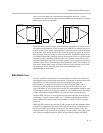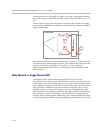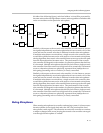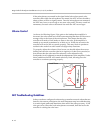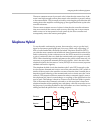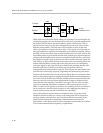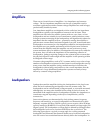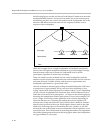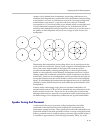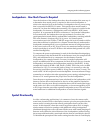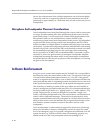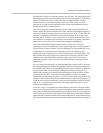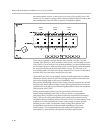
Designing Audio Conferencing Systems
B - 25
Loudspeakers - How Much Power Is Required
Once the locations of the loudspeakers have been determined, the next step is
to determine how much power is required to drive each loudspeaker to
achieve the required level at the listeners. Loudspeakers have a power rating
that is expressed in dB SPL @ 1 meter. This specifies how much sound is
created at 1 m from the loudspeaker assuming 1 W of power is applied to the
loudspeaker. For instance a loudspeaker rated at 86 dB SPL 1 Watt/meter
requires 1 W to generate 86 dB SPL at a distance of 1 m from the loudspeaker.
In a normal room, the loudspeakers are approximately 2 m above the
participant that is seated directly underneath a loudspeaker, resulting in 80 dB
SPL at the listener's location with 1 W of power. As normal speech
conversations are in the 70 dB to 77 dB SPL range, this level of sound would be
more than sufficient for playback for a listener located directly underneath a
loudspeaker assuming there is not a significant amount of background noise
in the room (such as in an NC 30 style room). As mentioned earlier, having a
sound system that is at least 25 dB above the ambient background will yield
excellent intelligibility.
To compute the power requirements for each of the distributed loudspeakers,
it is convenient to take the desired SPL at the listeners' ears (for example 85 dB
SPL), add additional level to compensate for the distance from the
loudspeakers (for example listeners 2 m away from the loudspeaker will
require an additional 6 dB to compensate for the 6 dB loss 2 m away from the
loudspeaker), and subtract the loudspeakers sensitivity (86 dB SPL). In this
example this results in 85 dB + 6 dB - 86 dB = 5 dBW. This is the power in dBW
(referenced to 1 W). To convert this back to Watts, it is necessary to take the
inverse log (recall that a power in dBW is 10 log (Power in watts/1 watt)). The
result is that 3.16 W is required for each loudspeaker. As most constant voltage
systems have a switch to select the appropriate power setting, selecting the tap
closest to 3 W would generate the proper level for the loudspeakers.
Once the power requirements have been calculated for the loudspeakers, add
them up and use this as the baseline for the size of the amplifier required to
drive audio into the room. Keep in mind that there will be transformer losses
on the order of a 1 dB or so for each loudspeaker, so choose an amplifier at 25%
to 50% larger than the sum of the required loudspeaker power. This will allow
some headroom for additional loudspeakers or louder transient signals.
Spatial Directionality
In video conferencing applications, it is common to have the remote audio
come from a location close to the display screen to give the perception that the
remote audio is coming from the remote participants shown on the video
screen. In this situation, when the room is larger than about 20 ft. in length,
reinforcement of the front speakers with additional ceiling loudspeakers
distributed through the room will better fill the room with sound (keeping all
listeners well within the critical distance of the loudspeakers) without losing
the perceptual directionality associated with the front of room display device.
To maintain the perception of the audio coming from the front of room display



